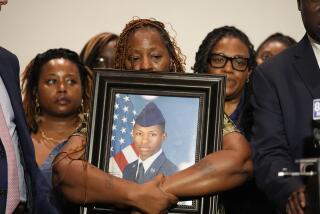U.S. report: Afghan officer who killed Americans was anti-U.S.
- Share via
Reporting from Washington — An Afghan officer who gunned down eight U.S. Air Force advisors and a contractor last year had previously threatened to kill Americans and was known to follow Taliban religious teachings, according to an Air Force report on the incident.
U.S. and Afghan officials suggested in the days after the April 27 incident, one of the deadliest in a string of attacks on U.S. troops by Afghan military personnel, that Col. Ahmed Gul had been showing signs of stress, possibly because of financial difficulties and health problems.
But the 436-page report by the Air Force Office of Special Investigations offers at least as much evidence that Gul harbored long-standing hostility toward the United States and its allies and carefully planned the attack to inflict as many casualties as possible. It also raises questions about the vetting that Afghan recruits undergo to ensure that insurgent sympathizers do not infiltrate the ranks.
In the attack, Gul drew his sidearm without warning and began firing at American advisors gathered for a morning meeting in the command center of the Afghan air force at the Kabul airport. He later killed himself after writing “God is one” and “God in your name” in blood on the walls of the headquarters.
U.S. officials have sought to play down the dangerous possibility that insurgents have penetrated the Afghan armed forces, arguing that many attacks on coalition personnel by Afghan recruits stemmed from personal grievances or psychological problems.
Witnesses, whose names are redacted in the report, described an atmosphere of pervasive mistrust between the Afghans and their U.S. Air Force trainers, fueled in part by Afghan hostility over the decade-old U.S. presence in their country and American perceptions that the Afghan air force was being used by corrupt officials to move illicit cargo.
“There were two different types of Afghans,” the report quotes an American advisor as saying. “Those who liked or at least tolerated the U.S. presence and those who did not.” Gul “clearly did not like the U.S. presence, due to his mannerisms, antisocial behavior, and lack of dialogue or discussion with U.S. military members.”
Gul had served as an Afghan military helicopter pilot in the 1990s, when the country was controlled by the Taliban’s Islamic fundamentalist regime. He moved to Pakistan after the U.S.-led invasion, where he was said by several witnesses to have become more devout.
The report quotes him as saying that “he wanted to kill Americans” when he returned in 2008 and sought to rejoin the Afghan military, but officials “did not believe him.” He was considered a “reformed Taliban” and allowed to rejoin the Afghan military because it needed experienced pilots, according to Afghan officials quoted in the report.
Gul, who was 46, oversaw daily cargo flights from the military air base at Kabul International Airport. In private, he voiced bitterness over the presence of American forces. Several U.S. and Afghan witnesses described him as a “chameleon” who could be pleasant and cooperative in the presence of U.S. officers, but hostile at other times.
On April 27, Gul, who had taken target practice two days before, walked into the operations center at 10 a.m., when U.S. and Afghan officers were gathered for a morning meeting. He pulled a sidearm from his holster and began firing.
He moved quickly through the large room, “shooting continuously in multiple directions” as Afghans and Americans dived under desks and rushed for the door, a witness told investigators.
In an adjoining conference room, Capt. Nathan J. Nylander, 35, of Hockley, Texas, heard the shots and ran into the hallway as others rushed outside. Seeing Gul come out of the operations center, Nylander fired his sidearm but was apparently shot himself. He was later found dead outside, near the entrance of the building.
When the shooting was over, the dead included a U.S. Air Force lieutenant colonel, four majors, two captains and a master sergeant. The U.S. contractor who was killed was a retired lieutenant colonel.
It was the single worst attack involving Air Force casualties since 1996, when terrorists bombed the Khobar Towers barracks in Dhahran, Saudi Arabia, killing 19 airmen. Intelligence reports examined by Air Force investigators did not directly link Gul to insurgents, but that possibility could not be ruled out, the report says.
The report says Gul had sold his house a year before the shooting and family members reported that he suffered from depression, which they attributed to physical problems the overweight pilot experienced after his helicopter crashed in the mid-1990s.
More to Read
Sign up for Essential California
The most important California stories and recommendations in your inbox every morning.
You may occasionally receive promotional content from the Los Angeles Times.











